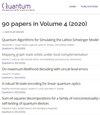Comparative study of quantum error correction strategies for the heavy-hexagonal lattice
IF 5.1
2区 物理与天体物理
Q1 PHYSICS, MULTIDISCIPLINARY
引用次数: 0
Abstract
Topological quantum error correction is a milestone in the scaling roadmap of quantum computers, which targets circuits with trillions of gates that would allow running quantum algorithms for real-world problems. The square-lattice surface code has become the workhorse to address this challenge, as it poses milder requirements on current devices both in terms of required error rates and small local connectivities. In some platforms, however, the connectivities are kept even lower in order to minimise gate errors at the hardware level, which limits the error correcting codes that can be directly implemented on them. In this work, we make a comparative study of possible strategies to overcome this limitation for the heavy-hexagonal lattice, the architecture of current IBM superconducting quantum computers. We explore two complementary strategies: the search for an efficient embedding of the surface code into the heavy-hexagonal lattice, as well as the use of codes whose connectivity requirements are naturally tailored to this architecture, such as subsystem-type and Floquet codes. Using noise models of increased complexity, we assess the performance of these strategies for IBM devices in terms of their error thresholds and qubit footprints. An optimized SWAP-based embedding of the surface code is found to be the most promising strategy towards a near-term demonstration of quantum error correction advantage.重六方晶格量子纠错策略的比较研究
拓扑量子纠错是量子计算机扩展路线图中的一个里程碑,量子计算机的目标是具有数万亿个门的电路,这些电路将允许运行量子算法来解决现实世界的问题。方阵表面代码已经成为解决这一挑战的主力,因为它在所需的错误率和较小的本地连接方面对当前设备提出了较温和的要求。然而,在某些平台中,为了最小化硬件级别的门错误,连接性甚至保持更低,这限制了可以直接在其上实现的纠错码。在这项工作中,我们对克服当前IBM超导量子计算机体系结构重六角形晶格限制的可能策略进行了比较研究。我们探索了两种互补的策略:寻找一种有效地将表面代码嵌入到重六边形晶格中,以及使用连接要求自然适合这种架构的代码,例如子系统类型和Floquet代码。使用复杂性增加的噪声模型,我们根据错误阈值和量子位足迹评估IBM设备的这些策略的性能。一种优化的基于swap的表面码嵌入被认为是近期证明量子纠错优势的最有前途的策略。
本文章由计算机程序翻译,如有差异,请以英文原文为准。
求助全文
约1分钟内获得全文
求助全文
来源期刊

Quantum
Physics and Astronomy-Physics and Astronomy (miscellaneous)
CiteScore
9.20
自引率
10.90%
发文量
241
审稿时长
16 weeks
期刊介绍:
Quantum is an open-access peer-reviewed journal for quantum science and related fields. Quantum is non-profit and community-run: an effort by researchers and for researchers to make science more open and publishing more transparent and efficient.
 求助内容:
求助内容: 应助结果提醒方式:
应助结果提醒方式:


